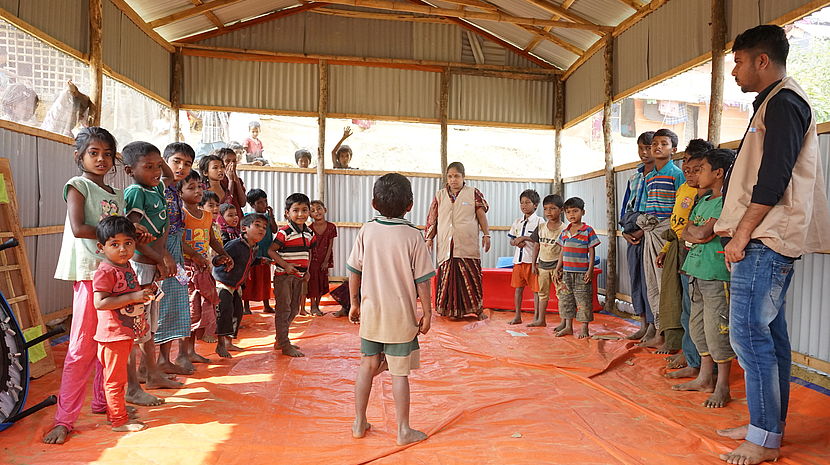12.11.2018 Oasis of accessibility

Our health and rehabilitation centre in Balukhali refugee camp felt like an oasis of accessibility, after being pushed, pulled, lifted and carried through the sucking mud to get there.
The short journey from the main road gave a vivid picture of just how physically challenging this place is, and the fact that I was the only person using a wheelchair is a reminder that many of the Rohingya refugees must spend their lives in or around their homes because of it.
And it’s not all just about physical accessibility. After being shown around, seeing the services being provided (healthcare, rehabilitation and mental health support, as well as an inclusive child-friendly space and home-based rehabilitation to seek out the people who can’t make it to the centre) we held a focus group discussion with people with disabilities from the refugee population. All were happy to have received support here, and several are still coming back for ongoing treatment. But they were quick to describe the issues accessing basic mainstream services in the wider camp, such as food, water and shelter.
A single mother spoke of little consideration being given to the fact her child needs more support than most, meaning she has less time to collect goods; a young man spoke of the terrain meaning he (on behalf of his family) was often last or late to reach distribution points. In situations like this, there are many other barriers, including attitude and awareness of staff and access to information and communication, which mean people with disabilities are routinely missed out.
For this reason, CBM and our partner organisation Centre for Disability in Development (CDD) are approaching the problem from two angles.
At the same time as providing these specialised services that are inclusive of everyone, we are working to positively influence the bigger picture. This means engaging with willing organisations to support them on making their interventions more inclusive too. As part of this work, during my visit, I took part in trainings with staff from International Federation of Red Cross and Red Crescent Societies (IFRC), and with IOM.
In providing such trainings, and ongoing support, we use experience and resources that have been developed from previous responses, and we showcase the inclusive work going on here in Bangladesh. The health and rehab centre is therefore more than just a service delivery point; it’s an example of what is really possible.
Beyond trainings, we are working on the development of inclusive learning centres with UNICEF, home-based rehabilitation with IOM and others, and mainstreaming disability in Oxfam/Care WASH, GBV and food security activities.
This work, with specific agencies, is a very good beginning towards making a significant positive change in disability inclusion. But as well as these formal collaborations, we are also engaging with the wider humanitarian community through the cluster system. Even though my visit was short, I had the chance to participate in two such meetings; one where I hope our intervention will ensure many learning centres will be designed (from the beginning) to be accessible, and another where data on child protection has been agreed to include information about disability (without being counted, there is no way of knowing if children with disabilities are included). These may seem small steps, and are not yet guaranteed to materialise, but would make significant changes in the lives of many people who are currently missing out.
The refugee camps have existed here for over a year. Much great work is being done and the resilience of the people is clear. Although we have a long way to go before aid is reaching everybody, I was encouraged by this visit. The need for inclusion is being recognised on many levels. It won’t happen overnight, and it will be a long time before a camp like this is fully wheelchair accessible, with more than just a few ‘oases of accessibility’, but we are going in the right direction.